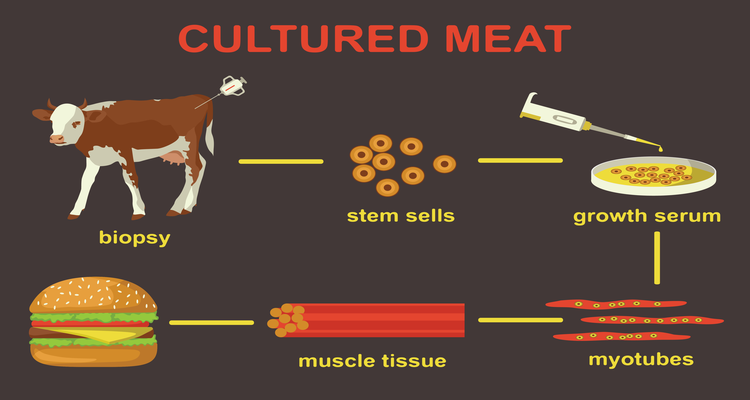◊ By Radhika Rao
Visit ORGANIC SHOP by Pure & Eco India
We live in a time of incredible contradiction. Even with mankind’s capabilities to continually innovate towards increasing efficiency in every aspect of life, we are still stuck with some of the world’s most inefficient systems—industrialised animal agriculture and the use of animals in research and toxicology.
Intensive confinement of farm animals has become the standard method of raising animals for food across the globe. This rudimentary system severely compromises animal welfare and impacts the environment negatively. Animals raised to produce food are condemned to a life of misery. Their welfare is compromised to increase their productivity. Regulatory policies that are meant to ensure the safety of animal products are more often than not, poorly implemented, resulting in grave public health hazards.
Additionally, international bodies such as the Food and Agricultural Organization and the EAT Lancet Commission, among others, have recognised animal agriculture as one of the most environmentally destructive industries on the planet. In line with these findings, countries such as Canada and China, among others, are developing dietary guidelines that recommend a shift in diet towards a reduced consumption of animal-based food, and increased consumption of plant-based food.
Similarly, the use of animals in research and toxicology is a grossly inefficient practice that has been in use for decades. An estimated 115 million or more animals, ranging from zebrafish to non-human primates, are used globally each year for research, testing and education via dissection.
Animals kept in laboratories are likely to undergo some level of physical and psychological distress, and animals used for the most invasive or ‘severe’ category of experiments are subjected to painful or stressful procedures, often without any anaesthetic or pain relief. Innumerable animals are subjected to pain and killed each year for animal testing (these animals are considered so inconsequential that even the data on the number of animals used in animal-testing is seldom maintained) even though animal tests have scientific limitations, as different species have different responses on exposure to the same chemicals. Consequently, results from animal tests are more often than not irrelevant to humans, as they can under- or overestimate real-world hazards to people.
However, two of these massive challenges find a common solution. Significant scientific developments have taken place over the past decade showing great promise to alleviate these concerns. In-vitro technologies, in which desired cells are isolated and grown in a medium, are creating revolutionary changes in both these industries.
The Organisation for Economic Co-operation and Development has approved of human-based in-vitro methods for replacing animal testing for skin and eye sensitivity tests
Cell-based meat (also referred to as clean meat or cultured meat, among other names) is grown from animal cell cultures in a controlled and sterile environment. In lieu of raising and slaughtering millions of animals for food, cell-based meat is produced by extracting a small sample of cells and growing them in a laboratory environment to produce meat that is nutritionally and sensorially equivalent to conventional meat. The required components of the meat product (muscle, fat tissues, etc) are developed using tissue engineering.
California-based Memphis Meats, Dutch company Mosa Meat, and Shiok Meats of Singapore are pioneering the cultured meat movement
With a rapidly increasing population that is incorporating a higher amount of animal protein in their diets, there is an urgent need to develop sustainable protein production practices, and cell-based meat offers a large potential to do so.
At the same time, in-vitro technologies are increasingly being recognised as more efficient alternatives to the use of animals in laboratories. Cell cultures, organ cultures, tissue slices, primary cell cultures, established cell lines, stem cells can all prove to be potential and promising alternatives to animals. Organ-on-a-chip, a multi-channel 3-D microfluidic cell culture chip that stimulates the activity, mechanics, and physiological responses of entire organs and organ systems, acts as a type of artificial organ, is an alternative that has been developed for effective testing.
In-vitro technologies, for both of these domains, have been a growing subject of interest for scientific researchers, and are seeing significant investments from governments and the industry. Since the 2013 European ban on sales of newly animal-tested cosmetics, countries including the United States, United Kingdom, and Netherlands have invested in the development of modern animal testing alternatives. Furthermore, countries like India, Israel, and Norway have adopted similar bans on animal-tested cosmetic products.
The Organisation for Economic Co-operation and Development (OECD), approved of human-based in-vitro methods for replacing animal testing for skin and eye sensitivity testing. The National Research Council (NRC), in its seminal 2007 report Toxicity Testing in the 21st Century: A Vision and A Strategy, described a “transformative paradigm shift” that envisions in-vitro tests for use in key toxicity pathways. These in-vitro technologies are the modern alternatives that will replace animals in laboratories.
The United States, United Kingdom and Netherlands have invested in the development of modern alternatives to animal testing. India, Israel and Norway have also adopted bans on animal-tested cosmetic products
Similarly, several governments across the world, such as India, Israel, Japan, and more have invested in cell-based meat companies, with even the largest meat companies in the world, such as Tyson Foods, Cargill Foods, and Maple Leaf Foods leading the investments. In just the past two years, dozens of cell-based meat companies have been established, such as Memphis Meats, Mosa Meat and Shiok Meats, among others, with several already having showcased their products.
Technology has proven to be the ultimate solution for animals—human and non-human alike. While less than a century ago, horses were used for transportation and pigeons were used to carry messages, technological developments led to the introduction of cars and the Internet, which not only brought a large number of animals out of suffering but also proved to be vastly more efficient systems.
In view of our global food sector, particularly animal agriculture, with its questionable ethical and sustainability practices, and the use of animals for testing with its unacceptable inefficiencies, we, as conscious consumers must embrace these life-saving technologies.
ABOUT THE AUTHOR

The author is Campaign Manager for Institutional Meat Reduction, Humane Society International, India



A well researched paper, touching possible nuances involved in the subject.
The paper would have been more assertive with a touch of socio-economic and socio-political issues involved in the subject.
Nevertheless, it is an excellent paper and a dedicated effort by the author.